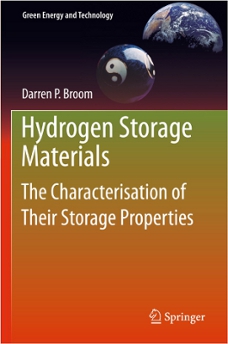
2011 · VIII,
256 pp. · 20 illus., 3 in color ·
Green Energy
and Technology ·
Hardcover
ISBN 978-0-85729-220-9
|
Hydrogen Storage Materials
The Characterisation of Their Hydrogen Storage
Properties
Darren P. Broom
The problem of storing hydrogen safely and
effectively is one of the major technological barriers
currently preventing the widespread adoption of hydrogen
as an energy carrier and the subsequent transition to a
so-called hydrogen economy. Practical issues with the
storage of hydrogen in both gas and liquid form appear to
make reversible solid state hydrogen storage the most
promising potential solution. Hydrogen Storage Materials addresses the
characterisation of the hydrogen storage properties of the
materials that are currently being considered for this
purpose.
The background to the topic is introduced, along with the
various types of materials that are currently under
investigation, including nanostructured interstitial and
complex hydrides, and porous materials, such as
metal-organic frameworks and microporous organic polymers.
The main features of Hydrogen
Storage Materials include:
- an overview of the different types of hydrogen storage
materials and the properties that are of interest for
their practical use;
- descriptions of the gas sorption measurement methods
used to determine these properties, and the
complementary techniques that can be used to help
corroborate hydrogen uptake data; and
- extensive coverage of the practical considerations for
accurate hydrogen sorption measurement that drive both
instrument design and the development of experimental
methodology.
Hydrogen Storage Materials
provides an up-to-date overview of the topic for experienced
researchers, while including enough introductory material to
serve as a useful, practical introduction for newcomers to
the field.
Buy
Now at Springer.com
Read
Sample Material at SpringerLink.com
Preview
on Google Books
Download
a free pdf of Chapter 2 from Springer.com
Find
a Copy at a Library using WorldCat
Download
from iTunes
The Chinese Edition is
now available!
And the English
Hardback edition reached #1 in Energy
Conversion & Storage on Amazon.co.uk in mid-March
2014!
|
|
Contents |
|
|
|
Preface
|
|
Acknowledgements
|
|
Table
of Contents
|
|
Chapter 1 - Introduction
|
|
Chapter 2 - Potential
Storage Materials
|
|
Chapter 3 - Hydrogen
Sorption Properties of Materials
|
|
Chapter 4 - Gas
Sorption
Measurement Techniques
|
|
Chapter 5 - Complementary
Characterisation Techniques
|
|
Chapter 6 - Experimental
Considerations
|
|
Chapter 7 - Concluding
Remarks
|
|
Index
|
|
|
|
Reviews |
|
"When compared with fossil fuels, hydrogen comes out on top
in every comparison, except one. Hydrogen is the lightest
fuel, the most efficient fuel and the cleanest fuel.
However, for a given amount of energy, its storage is
heavier and takes more volume, as compared with fluid fossil
fuels, i.e., petroleum and natural gas. Hence, extensive
R&D activities around the world are taking place in
order to improve the gravimetric and volumetric storage
properties of hydrogen. In this respect, Hydrogen Storage
Materials offer the best promise. The book Hydrogen Storage Materials:
The Characterisation of Their Storage Properties by
Darren P. Broom admirably presents the latest knowledge and
research results on this important topic. Consequently, I
strongly recommend this book to hydrogen energy scientists
and engineers in general, and to those involved in the
storage of hydrogen in particular."
T. Nejat Veziroglu, President of the International
Association for Hydrogen Energy
"The book contains an impressive number of useful and
topical references, and a descriptive introductory chapter
outlining the search for a viable solid state store...[It]
provides a good overview of these developments which sets
the scene for the subsequent chapters which concentrate in
commendable detail on the measurement techniques...In
summary therefore, the search for a viable, lightweight
solid state hydrogen storage material continues and to aid
this task, this book provides a very valuable addition to a
researcher's shelf."
Rex Harris, International
Journal of Hydrogen Energy, Volume
37, Issue 9 (2012) p. 7950-7951
|
|
Errors,
Corrections and Comments |
|
|
|
Additional Book Chapters |
|
|
|
Gas
Storage in Metal-Organic Frameworks
|
|
|
|
This chapter covers the storage of hydrogen,
methane and carbon dioxide in metal-organic frameworks. It
begins by considering the applications for hydrogen, methane
(natural gas), and carbon dioxide storage. It then discusses
materials requirements, before covering H2, CH4,
and CO2 adsorption by different MOFs. Manometric
and gravimetric gas sorption measurements are then described
and experimental considerations for performing accurate
measurements are discussed in some detail. The chapter
concludes with a discussion of future research trends. |
|
|
|
This is Chapter 9 in Gas
Adsorption in Metal-Organic Frameworks: Fundamentals and
Applications, a book edited by Grant Glover and Bin
Mu. It was co-authored with Jacob Burress of Avon Protection
Systems Inc.
|
|
|
|
Hydrogen
Storage in Nanoporous Materials
|
|
|
|
This chapter covers hydrogen storage in
nanoporous materials, which is one of the options currently
being considered for automotive or mobile applications. It
first introduces the principles behind hydrogen adsorption
by these materials and the methods used to characterise
their hydrogen storage properties. It then provides an
overview of the different material types that are available
– including porous carbons, zeolites, metal-organic
frameworks and microporous organic polymers – and their most
important hydrogen storage properties. The chapter concludes
with a discussion of the use of nanoporous materials in
practical hydrogen storage units, the most important
considerations for this purpose, and a discussion of future
trends in the area.
|
|
|
|
This is Chapter 15 in Advances
in Hydrogen Production, Storage and Distribution, a
book edited by Angelo Basile and Adolfo Iulianelli. The
chapter was co-authored with David
Book of the University of Birmingham, UK.
|
|
|
|
Preview
on Google Books |
|
|
|
Buy
Advances in Hydrogen Production, Storage and Distribution
Now at Elsevier.com |
|
|
|
New Articles
|
|
|
|
Concepts
for Improving Hydrogen Storage in Nanoporous Materials
|
|
|
|
This article discusses approaches to
increasing the gravimetric and volumetric hydrogen storage
capacities of nanoporous materials, and maximizing the
usable capacity of a material between the upper storage and
delivery pressures. The use of machine learning to search
for new Metal-Organic Frameworks (MOFs) is also covered,
together with some new material types that could prove
useful in the future for hydrogen storage applications.
|
|
|
|
The article was published in the International
Journal of Hydrogen Energy and is open access. It can
therefore be downloaded
from the IJHE website.
|
|
|
|
Pitfalls
in the Characterisation of the Hydrogen Sorption
Properties of Materials
|
|
|
|
This article, published in the International
Journal of Hydrogen Energy in December 2017 and
co-authored with Jim
Webb of Griffith University in Brisbane, Australia,
discusses the pitfalls that can be encountered when
measuring hydrogen sorption by materials. It considers
instrument design and calibration, sample size choice,
sample and gas purity, isotherm measurement procedure and
issues associated with data reduction, together with
approaches to validating equipment and isotherm
measurements. |
|
|
|
Irreproducibility
in Hydrogen Storage Material Research
|
|
|
|
Publication of questionable data continues to
be a problem in research into new hydrogen storage
materials, despite the well-documented cases that have
appeared in the literature over the course of the last 20
years. This article, published in the RSC journal Energy
& Environmental Science and co-authored with Michael
Hirscher of the Max Planck Institute for Intelligent
Systems in Stuttgart, Germany, describes a number of cases
of irreproducible results that have appeared in the
literature since the late 1990s. Cases covered include
carbon nanotubes, carbon nanofibres, boron nitride (BN)
nanotubes, conducting polymers, metal-organic frameworks
(MOFs) and the use of hydrogen spillover to enhance the
storage properties of various nanoporous materials; however,
possible reasons behind the problems and ways of avoiding
further problems in the future are also addressed.
|
|
|
|
The article is open access, and thus
available to download
on the Royal Society of Chemistry (RSC) website or to
read
in html format.
|
|
|
|
Outlook
and Challenges for Hydrogen Storage in Nanoporous
Materials
|
|
|
|
Considerable progress has been made recently
in the use of nanoporous materials for hydrogen storage. In
this article, the current status of the field and future
challenges are discussed, ranging from important open
fundamental questions, such as the density and volume of the
adsorbed phase and its relationship to overall storage
capacity, to the development of new functional materials and
complete storage system design. With regard to fundamentals,
the use of neutron scattering to study adsorbed H2,
suitable adsorption isotherm equations, and the accurate
computational modelling and simulation of H2
adsorption are discussed. The new materials covered include
flexible metal–organic frameworks, core–shell materials, and
porous organic cage compounds. The article concludes with a
discussion of the experimental investigation of real
adsorptive hydrogen storage tanks, the improvement in the
thermal conductivity of storage beds, and new storage system
concepts and designs.
|
|
|
|
The article is open access, and thus
available to download
on the Springerlink website or to read
in html format.
|
|
|
|
It is part of an Applied Physics A
Topical Collection on Hydrogen-Based
Energy Storage, compiled from contributions by
participants in the International Energy Agency (IEA) Hydrogen Implementing Agreement
(HIA) Task
32.
|
|
|
|
A
Tribute to Professor Keith Ross
|
|
|
|
I've written a short tribute to Keith, my PhD
supervisor at the University of Salford, which is included
in the Preface
of the MH2016 conference proceedings in the
International Journal of Hydrogen Energy.
The above links to a longer version. I would very much
welcome any feedback or corrections.
|
|
|
|
Other Downloads
|
|
|
|
Assessing
the Performance of Potential Hydrogen Storage Materials
|
|
|
|
(English manuscript of an
article published in Russian in World Alternative
Energy magazine, August 2012, p. 18-25)
|
|
|
|
About the Author |
|
|
|
 |
Darren Broom is
a product manager for Hiden Isochema
Ltd, a manufacturer of analytical gas and
vapour sorption instrumentation. He holds a PhD from
the University of Salford's Institute for Materials
Research and, on completing his doctorate, went on
to work for the European Commission's Institute for
Energy where he assisted in the development of their
hydrogen storage material testing facility. He is a
member of the American Chemical Society, Materials
Research Society and the American Association for
the Advancement of Science, and is on the editorial
board of Green Carbon,
a new open access journal published by Elsevier.
|
|
|


Google
Scholar Citation Record - Darren P. Broom
2012 list of
outstanding and exceptional reviewers for the AIP journal
Review of Scientific Instruments
Please send any comments, questions, suggestions or
corrections to darrenbroom@inbox.com |


